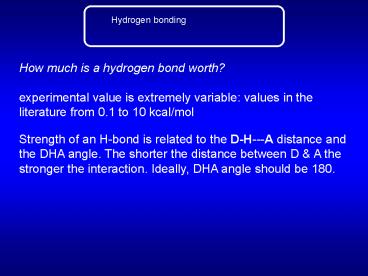How much is a hydrogen bond worth - PowerPoint PPT Presentation
1 / 18
Title:
How much is a hydrogen bond worth
Description:
How much is a hydrogen bond worth? ... Hydrogen Bonding. The Hydrophobic Effect ... Each molecule of water in the solid state is engaged in 4.0 hydrogen bonds. ... – PowerPoint PPT presentation
Number of Views:315
Avg rating:3.0/5.0
Title: How much is a hydrogen bond worth
1
How much is a hydrogen bond worth? experimental
value is extremely variable values in the
literature from 0.1 to 10 kcal/mol
Strength of an H-bond is related to the D-H---A
distance and the DHA angle. The shorter the
distance between D A the stronger the
interaction. Ideally, DHA angle should be 180.
2
Hydrogen bonding
If we calculate the energy of H-bond in
chloroform (? 4.8) to be 10 kcal/mol, if we
change solvent to water (? 78.8) all else being
the same we would expect the new energy of
interaction to be 10 . 4.8 / 78.8 0.6 kcal/mol
based on our equation for dipole-dipole
interactions. However, we find experimentally
that the H-bond is only worth 0.1 kcal/mol. Why
might this be?
R
2
O
H
3
Hydrogen bonding in water
ST2 Model of water molecule
4
Crystal Structure of Ice
5
(No Transcript)
6
Hydrogen Bonding
7
(No Transcript)
8
The Hydrophobic Effect
What does hydrophobic mean? What are examples of
hydrophobic molecules? When two hydrophobic
molecules are placed in water, they appear to be
strongly attracted to one another. This, however,
a highly deceptive appearance! The vdw force
between two hydrocarbons is weaker than vdw force
between a hydrocarbon molecule and a water
molecule. Hydrophobic molecules actually like
water molecules as they can interact with water
via dipole-induced dipole interactions. These
are stronger than induced dipole-induced dipole
forces (dispersion), the only possible type of
interaction between non-polar hydrophobic
molecules.
9
The Hydrophobic Effect
Each molecule of water in the solid state is
engaged in 4.0 hydrogen bonds. (accepting two and
donating two) Each molecule of water in the
liquid state is engaged in approximately 3.0 -
3.5 hydrogen bonds. What happens when a
hydrophobic molecule is added to the water?
10
The Hydrophobic Effect
11
The Hydrophobic Effect
In the example of n-butane in water at 25ºC the
equation breaks down as follows ?G ?H - T?S
24.5 kJ/mol ?H -4.3 kJ/mol -T?S 28.7
kJ/mol It is actually enthalpically favorable to
place n-butane in water, but it is very
unfavorable from an entropic perspective. Water
molecules which are in direct contact with a
hydrophobe have to freeze in attempt to
maintain a maximum number of H-bonds. Therefore,
they have to lose entropy. The larger the area
of such contacts, the more entropy will be lost
by water molecules.
12
The Hydrophobic Effect
Because of these entropic reasons, hydrophobic
molecules are squeezed out of the aqueous
medium. Main consequence The hydrophobic
effect is a unique organizing force, based on
repulsion of solute by the solvent instead of
attractive forces at the site of organization
Tanford, Science 1978.
13
The Hydrophobic Effect
14
The Hydrophobic Effect
The hydrophobic effect can be used for creating
well-defined supramolecular assemblies. Dependin
g on the size and the volume ratio of hydrophobic
and hydrophilic blocks of an amphiphile, zero-,
one-, and two-dimensional supramolecular
nanostructures can form.
15
Self-Organization of Amphiphiles Driven by the
Hydrophobic Effect
Cylindrical micelles of PS-PAA amphiphile
Spherical micelles of PS-PAA amphiphile
16
Self-Organization of Amphiphiles Driven by the
Hydrophobic Effect
Vesicles of PS-PAA amphiphile
Vesicles inside vesicles
17
Self-Organization of Amphiphiles Driven by the
Hydrophobic Effect
Baroclinic tubes
Tubes
18
Self-Organization of Amphiphiles Driven by the
Hydrophobic Effect
Tube-walled vesicles
Starfish micelles































